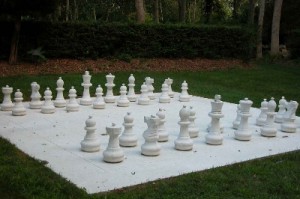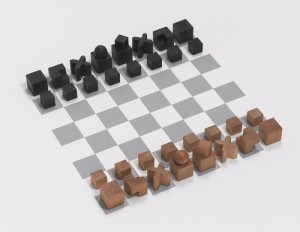Jazz is like…chess?
Editor’s Note: While we’re all excited for this Saturday’s double-bill with the Vijay Iyer Trio and Rudresh Mahanthappa’s Apex, not all of us are as well-versed in jazz from the cutting edge as we’d like to be. Lucky for us, Andrew Bishop, Assistant Professor of Jazz and Contemporary Improvisation at U-M, is here to help. Read on for Andrew’s outstanding explanation of how Vijay and Rudresh are expanding the language of jazz and what we can listen for at the concert this Saturday.
Jazz has often been compared to the game of chess. Both are sophisticated constructs that require invention and reinvention to play with a fresh voice and approach. Both demand constant study, practice and imagination. Even a novel opening move compels in-the-moment flexibility to navigate through unexpected turns. Great players develop a style that becomes a their trademark move, gesture or phrase.
Often neglected in this analogy is the notable connection of chess set design and its similarity to jazz composition. Like the designer, the composer works to find novel ways to organize and craft materials. It is the players, however, that shape the moves through their own style and personality.
Variations on chess set design are also a convenient way to encapsulate the countless directions jazz is expressed. For example, a gothic model might be compared to traditional jazz formats while designs that incorporate current trends in popular culture (a set with Harry Potter characters for example) to a jazz trio performing a Madonna tune.
There are also designs that seem to stray completely beyond the game’s intent, for example Yoko Ono’s all white “pacifist” chess set.
Here the design is intentionally fashioned so the players lose track of their offensive strategy and gain empathy for their opponent. The esoteric nature of this design is not unlike the many artists exploring sound outside of the traditional boundaries of harmony, melody and traditional instrument techniques. This is also akin to a jazz improviser’s method of creating a musical problem to intentionally remove clichés or patterns (often called “cookie cutters” or “ready made ideas” by musicians in the field).
It is perhaps the design of Josef Hartwig’s “Bauhaus” chess set that is most befitting a comparison to the music of Vijay Iyer and Rudresh Mahanthappa and their many collaborators and colleagues.
Upon first glance the set may appear to break all of the rules—the knights don’t look like horses, the royal figures don’t have crowns, etc. However, when you examine the chess set deeply the figures reveal a notable detail: they are shaped to signify the way the pieces move on the board. This is a remarkable marriage of form and function and a well crafted, thought provoking, and beautiful departure from the norm while embracing a fundamental aspects of the game. The music of Vijay Iyer and Rudresh Mahanthappa exhibits many of the same traits: intelligent in its design, highly personal in its language while remaining respectful of the various traditions from which the music has spawned.
Expanding the Language of Jazz
Vijay Iyer and Rudresh Mahanthappa are a part of a large cadre of artists expanding the color palette of jazz. While each artist brings a personal approach and aesthetic path to the table, there are a few cogent elements that emerge as notable trends:
- Larger compositional frameworks drawn from diverse musical sources and influences
- The influence of world and folk music forms
- Inspiration from the popular musical canon beyond Tin Pan Alley song forms
- A search for an individual (or collective) improvisation and composition language
- Extended instrument techniques to expand sonic resources
- The influence and interaction with computers and technology
- Interdisciplinary inspiration (mathematics, history, biology, and literature for example)
Perhaps the most noteworthy element, these ideas go beyond an abstract method for musical ideas but are also an attempt to connect the music to the broader cultural environment we inhabit in the twenty-first century.
A Few Musical Excerpts with Brief Commentary
Here is a You Tube clip of a work called “The Preserver” performed by the duo Raw Materials (Iyer and Mahanthappa) live at the JVC Jazz Festival. The work navigates with ease through composed elements, improvisation and dialogue between the performers.
“Mystic Brew” was originally recorded by jazz-soul organist Ronnie Foster but received a rebirth when the hip-hop group Tribe Called Quest used the opening chord progression as a sample (or loop) in “Electronic Relaxation.” In this performance, the Vijay Iyer Trio establishes the tunes chord progression but deconstructs it rhythmically throughout.
The following link demonstrates one of Iyer’s explorations with technology, here in a duo improvisation with HPrizm on interactive laptop.
One of the most globally minded projects of both artists is Rudresh Mahanhtappa’s Indo-Pak Coalition featuring Rez Abbasi and the amazing Dan Weiss on tablas. (Weiss, a remarkable performer and composer in his own right, has also fully integrated tabla technique to the drum set). In this link, Mahanthappa uses expanded saxophone techniques to incorporate microtonal effects (a musical sound which finds steps in between the half-step—the smallest interval on the piano). While this is not a standard practice in Western music, microtonal gestures are a regular part of the expressive palette of many world music cultures.
Postscript: Bunky Green
Few artists can truly claim to have a “voice changing” presence on their instrument, but Bunky Green arguably set forth a sound that would influence the alto saxophone for decades to come. Many important alto players—including Steve Coleman, Greg Osby, and of course Rudresh Mahanthappa—owe a tip of the hat to his sound, approach to harmony, rhythmic sense, sonic nuance, fierce articulation and linear development. He was so idealized and revered by Steve Coleman that the young protégé used to sit outside Green’s window just to listen to him practice. Like the Bauhaus chess set, his pure, focused tone is the perfect marriage for the logic of his improvisational language.
Here is a link to a video about the collaboration between Mahanthappa and Green called Apex.
UMS Arts Roundup: October 15
Many members of the UMS staff keep a watchful eye on local and national media for news about artists on our season, pressing arts issues, and more. Each week, we pull together a list of interesting stories and share them with you. Welcome to UMS’s Arts Round-up, a weekly collection of arts news, including national issues, artist updates, local shout-outs, and a link or two just for fun. If you come across something interesting in your own reading, please feel free to share!
Arts Issues
- The Detroit Symphony Orchestra strike continues, and the DSO has canceled orchestral concerts through November 7. Non-orchestral concerts, education programs, and rentals continue as scheduled.
Artist Updates
- Soprano Joan Sutherland died Sunday at age 83. Leave your memories of her three UMS performances here.
- Rudresh Mahanthappa launched his new website this week, where you can stream his latest album, Apex.
- Muti update: Riccardo Muti is out of the hospital, recovering from extreme exhaustion from prolonged stress.
- Name the seasons! Stream Philip Glass’ American Four Seasons and follow the Venice Baroque Orchestra/Robert McDuffie Seasons Project Tour on GoogleMaps.
UMS News
- The Mariinsky Orchestra, Valery Gergiev and Denis Matsuev opened our Choral Union Series on Sunday afternoon. You can also read comments from the audience.
- Review of last night’s Schubert concert by the Takács Quartet.
Local Shout-Outs
- If you’ve never been to the U-M Halloween Concert, it’s a real treat (with some tricks too)! Members of the University Symphony and Philharmonic Orchestras perform in this annual event on October 31 at Hill Auditorium.
Just For Fun
- Ok, maybe not “for fun”…but bedbugs were found last week in dressing rooms at Lincoln Center! They’ve turned up so far at the David H. Koch Theater, home of the New York City Ballet, and have spread to the Met.
- The YouTube Symphony Orchestra returns for its second year! Get out your instruments: audition submissions close on November 28.
17th Annual Jazz Series Announced
With four different events, the UMS Jazz Series celebrates jazz’s diversity, highlighting the best in modern jazz while honoring jazz’s legacy:
Silent Surrealism
Celebrating Django Reinhardt’s 100th Birthday
The Hot Club of San Francisco
The Hot Club of Detroit
Friday, October 29 | 8 pm
Michigan Theater
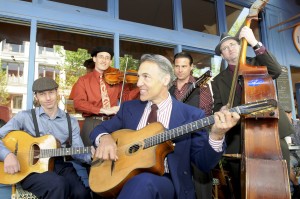 The Hot Club of San Francisco is an ensemble of accomplished and versatile musicians celebrating the music of Django Reinhardt and Stéphane Grappelli’s pioneering Hot Club de France. Fast forward 80 years. Continuing this early French tradition, a similar scene plays out as the Hot Club of San Francisco presents Silent Surrealism, an evening of live Gypsy jazz with short silent films from the 1930s by Charlie Bowers, James Sibley Watson, and Harold Shaw, courtesy of the San Francisco Silent Film Festival. Django Reinhardt is rightly hailed as one of the greatest guitarists who ever lived, but many people praising his accomplishments as a guitarist tend to overlook his roots in Gypsy culture and the fertile, polyglot Paris of the 1920s. Reinhardt and his companions used all these elements, along with American jazz, to create this new music, but the Gypsy heritage seems to be the most important ingredient. The Hot Club of San Francisco and the Hot Club of Detroit join together for this celebration of Django Reinhardt’s 100th birthday.
The Hot Club of San Francisco is an ensemble of accomplished and versatile musicians celebrating the music of Django Reinhardt and Stéphane Grappelli’s pioneering Hot Club de France. Fast forward 80 years. Continuing this early French tradition, a similar scene plays out as the Hot Club of San Francisco presents Silent Surrealism, an evening of live Gypsy jazz with short silent films from the 1930s by Charlie Bowers, James Sibley Watson, and Harold Shaw, courtesy of the San Francisco Silent Film Festival. Django Reinhardt is rightly hailed as one of the greatest guitarists who ever lived, but many people praising his accomplishments as a guitarist tend to overlook his roots in Gypsy culture and the fertile, polyglot Paris of the 1920s. Reinhardt and his companions used all these elements, along with American jazz, to create this new music, but the Gypsy heritage seems to be the most important ingredient. The Hot Club of San Francisco and the Hot Club of Detroit join together for this celebration of Django Reinhardt’s 100th birthday.
Jazz at Lincoln Center Orchestra with
Wynton Marsalis
Wednesday, February 2 | 8 pm
Hill Auditorium
Led by the incomparable Wynton Marsalis, who conceived and built this ensemble into the irresistible force it is today, the 15-member Jazz at Lincoln Center Orchestra returns for its near-annual Hill Auditorium appearnace. Despite one of the most aggressive touring schedules in the business, they make each concert seem fresh, drawing in audiences who are continually energized and amazed by the group’s depth of outrageous talent. “[The Jazz at Lincoln Center Orchestra] is not just a band on tour, but a religious congregation, spreading the word of jazz.” (Downbeat)
Vijay Iyer Trio and Rudresh Mahanthappa’s Apex
Saturday, February 12 | 8 pm
Power Center
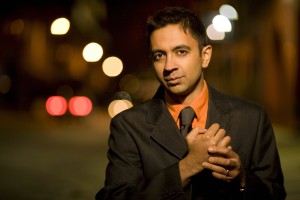 This double bill brings together two of today’s most interesting jazz combos. Dubbed one of “today’s most important pianists” by The New Yorker, Vijay Iyer is a singular talent: a forceful, rhythmically invigorating performer who weds a cutting-edge sensibility to a unique sense for compositional balance. An exceptional, forward-thinking composer, Iyer draws from African, Asian, and European musical lineages to create fresh, original music in the American creative tradition. His latest album, Historicity, received year-end acclaim for #1 Jazz/Pop Album of the Year (The New York Times) and #1 Jazz Album of the Year (National Public Radio and The Los Angeles Times). The second half of the program features alto saxophonist Rudresh Mahanthappa’s quintet Apex, which will be co-led by Mahanthappa and trendsetting septuagenarian hard-bop saxophonist Bunky Green. Mahanthappa, (who appears with Danilo Perez on April 8 at the Michigan Theater) is one of the most innovative young musicians and composers in jazz today. The two ensembles perform separate sets, then come together for a searing finale.
This double bill brings together two of today’s most interesting jazz combos. Dubbed one of “today’s most important pianists” by The New Yorker, Vijay Iyer is a singular talent: a forceful, rhythmically invigorating performer who weds a cutting-edge sensibility to a unique sense for compositional balance. An exceptional, forward-thinking composer, Iyer draws from African, Asian, and European musical lineages to create fresh, original music in the American creative tradition. His latest album, Historicity, received year-end acclaim for #1 Jazz/Pop Album of the Year (The New York Times) and #1 Jazz Album of the Year (National Public Radio and The Los Angeles Times). The second half of the program features alto saxophonist Rudresh Mahanthappa’s quintet Apex, which will be co-led by Mahanthappa and trendsetting septuagenarian hard-bop saxophonist Bunky Green. Mahanthappa, (who appears with Danilo Perez on April 8 at the Michigan Theater) is one of the most innovative young musicians and composers in jazz today. The two ensembles perform separate sets, then come together for a searing finale.
Septeto Nacional Ignacio Piñeiro de Cuba
Thursday, April 7 | 8 pm
Hill Auditorium
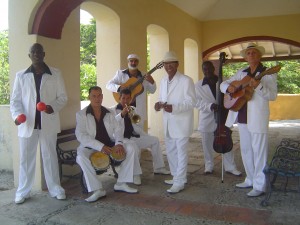 For more than 80 years and in over 35 countries, the Septeto Nacional Ignacio Piñeiro de Cuba has been the greatest and first champion of the traditional sound of the Cuban son. From the unmistakable twang of the tres to the smoky vocals of Eugenio “Raspa” Rodriguez, it is impossible to resist the infectious rhythms of this celebrated ensemble. The SNC performs some of the most treasured and well-known Cuban songs in the tradition of Ignacio Piñeiro Martínez, the legendary founder of the Septeto’s first incarnation in 1927 and one of the most important composers of son music. The group’s exceptional musicianship is firmly rooted in the musical explosion of Cuban son that took place during the 1920s and 1930s, evoking the nostalgic elegance of the dancing ballrooms and clubs of the era. The SNC recently played in the US for the first time since 1933 – more than 75 years ago. They are masters of Afro-Cuban rhythm and spirit, adding a splash of rumba to its son and delivering infectious, up-tempo fun. This band may be official cultural ambassadors from Cuba, but they know how to throw a party!
For more than 80 years and in over 35 countries, the Septeto Nacional Ignacio Piñeiro de Cuba has been the greatest and first champion of the traditional sound of the Cuban son. From the unmistakable twang of the tres to the smoky vocals of Eugenio “Raspa” Rodriguez, it is impossible to resist the infectious rhythms of this celebrated ensemble. The SNC performs some of the most treasured and well-known Cuban songs in the tradition of Ignacio Piñeiro Martínez, the legendary founder of the Septeto’s first incarnation in 1927 and one of the most important composers of son music. The group’s exceptional musicianship is firmly rooted in the musical explosion of Cuban son that took place during the 1920s and 1930s, evoking the nostalgic elegance of the dancing ballrooms and clubs of the era. The SNC recently played in the US for the first time since 1933 – more than 75 years ago. They are masters of Afro-Cuban rhythm and spirit, adding a splash of rumba to its son and delivering infectious, up-tempo fun. This band may be official cultural ambassadors from Cuba, but they know how to throw a party!
Jazz Series packages (all four concerts) range from $60 to $160. Subscription renewal packets and brochures will be mailed in early May.
Tickets to individual events on the series go on sale on Monday, August 23 (via www.ums.org) and Wednesday, August 25 (in person and by phone).


